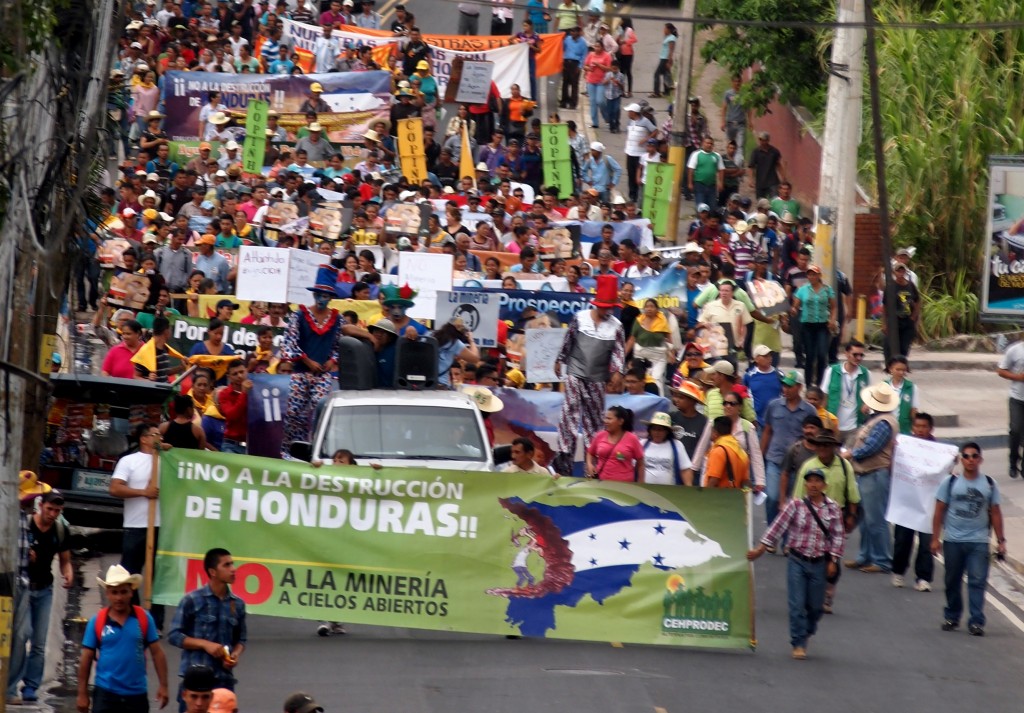
The anti-mining march flows from the hunger strikers protesting the corruption in Honduras, towards the site of the “First International Mining Congress”
19th July 2015
Honduras in Protest – Movements Align Against Corruption and Exploitation
While Honduras rocks from a wave of protest against the corruption rife within his government and its business links, last week president Juan Orlando Hernández proudly hosted the “First International Mining Congress in Honduras”. The Congress invited international and Honduran business people and politicians to mingle with mining technicians and academics involved in the industry. It is the latest chapter in the government’s full-throttle attempt to convert Honduras into one of the most heavily mined countries in the world – and convert the country’s land and environment into profit for politicians and big businesses. Mining in Honduras probably provides the clearest example of the corruption, hypocrisy and destruction inside the so-called “development” brought by transnational companies and their political links. While Orlando’s mining congress’ slogan promises “Responsible mining and Higher economic growth” [1] the true promises of his national mining project are more desolation, disease, poverty and repression. I was with COPINH as they joined national NGOs and hundreds of people to protest outside the Congress and attempt to get their side of the story heard.
COPINH provided two buses to bring a large number of their members half a day’s journey from the departments where they are based. As I wrote on the 7th of July, our numbers reinforced the Indignados hunger strike camp, just as the police were starting to push in on the camp. Several of the COPINH members, including campesinos from San Juan, also visited the National Agrarian Institute, to maintain the pressure necessary to have their land rights cases taken seriously. I will follow up these issues in my final two blog articles, but they aren’t independent of problems with mining. Honduras’ corruption and the commodification and privatisation of land which communities on live are factors that enable and support mining investment, and promote the damage it has on locals. The struggle and anger of the Indignados mixed in solidarity with that of the anti-mining marches, and the land rights visits – in Honduras they are all one fight.
On the night of the 7th of July, after reinforcing the hunger strike camp, the group held an initial candle lit vigil outside the Hotel Clarion, the Mining Congress’ venue, in time for its inauguration evening. As COPINH coordinator Tomas Membreño explained to radio presenters that night, the candles represented the victims of the 3,000 deaths attributed to lack of healthcare due to the theft of public money. The following morning, Tomas also contributed to a press conference organised by the Platform of Social and Popular Movements of Honduras. The conference brought the anti-mining and anti-corruption voice to the mass media. They stated: “We reject completely this [Mining Congress] which expresses the political, patrimonial corruption of the government, [which puts] the sale of our natural resources, the sovereignty of our territory and the destruction of the present and future of our communities into the hands of exploitative foreign companies.” [2].
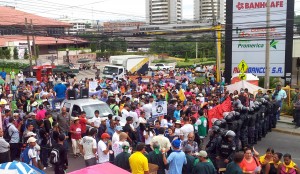
At the start of the anti-mining march the route past the Presidential House is blocked by a police line – the protesters moved up to the line in a show of their resolution to have their peaceful protest heard by the deaf ears of the president and the authorities
Later that day, COPINH joined many other social and environmental organisations in a public anti-mining protest that saw a a solid block of hundreds of people marching through the streets of the capital. The range of Honduran NGOs involved in the protest was impressive, with groups from all over the country and a wide range of stories of how mining had affected them. The march started from the Indignados’ hunger strike camp but was blocked by police and the military from heading past the Presidential House. After a tense stand off and shouts from the marchers of “Adelante” – “Forward” – against the police line, the march redirected itself in an alternative route. Their new path increased their visibility even more as it flowed along the main central highway of Tegucigalpa, to its end point back outside the Clarion Hotel. There they made their presence felt to the Congress members inside with speeches and many Honduran news teams.
A Mining Monologue – No Regulations, No Complaints
The main organisation coordinating the march was CEHPRODEC – the Honduran Center for the Promotion of Community Development. As the march was ending their Director José Espinoza explained to me that the Mining Congress inside was attempting to paint Honduran mining as a scientific, technical process, with extensive involvement of Honduran academics. However he said, in academic terms the Congress is only providing a “thesis” – the only invitees are pro-mining industrialists and politicians. The “anti-thesis” – the hundreds of voices from communities damaged by mining, and scientific evidence of the negative impacts of mining – have been left outside in the streets. This one-sided debate mirrors the spin Honduras’ people are witnessing from Juan Orlando in his response to the corruption crisis. While refusing an international, independent anti-corruption commission, he has initiated a national “dialogue” process to find solutions from within. But the only invitees to this dialogue are – say the Indignados marchers and Espinoza – those already within the corrupt system, the “dialogue” is simply an empty monologue that leads nowhere.
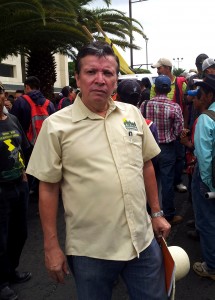
José Espinoza, Executive Director of the Honduran Center for the Promotion of Community Development (CEHPRODEC), explained to be the history of mining deregulation in Honduras
This negation of alternative voices is apparent in the legal framework that Juan Orlando has created in Honduras to support mining. In 2013 his government’s New General Mining Law came into effect [3]. Mining is now seen as an activity of national importance”, prioritised above concerns such as environmental or social impacts, or local consultation. In 2014 more than 50 Honduran civil society organisations were involved in an attempt to introduce a reform to this law that local consultation could produce binding requirements of mining contracts, but never received a response [4]. In November 2014 Juan Orlando introduced a “Re-engineering of environmental licensing processes” which aimed to dramatically shorten the time taken to get these licenses – effectively eradicating environmental protection in mining projects [5]. As a result of these moves, mining concessions in Honduras have mushroomed. There are now at least 873 concessions being planned, which concede a staggering near-30% of the country’s land surface area to mining operations [6]. Since then COPINH alone has filed 152 accusations of negligence against SERNA, the Ministry of Natural Resources and the Environment, for substance-less environmental licenses it has handed to mining companies. Juan Orlando has thrown Honduras’ doors open for zero accountability, no regulation mineral extraction for transnational companies to sink their teeth into.
The True Cost of Mining – Valle de Siria and Beyond
So far, much of these mining concessions are in early exploratory phases. The NGOs fighting them are trying to avoid the concessions developing into full blown mining, and they have plenty of examples of what is at stake. The most well known Honduran example is the San Martin mining project in Valle de Siria, owned by Canadian mining giant Goldcorp and started in the year 2000. This open pit mining project used explosives to blast apart the rocks from pits up to 100 hectares in area, to be processed for ores such as gold, copper, aluminium and zinc. Before this process, the land was privatised and sold. The community of Palo Ralo was moved 10 km, and the forest cleared wholesale. As part of the standard mining process, the extracted rock was cleaned in huge open tailing ponds with water and cyanide. Despite all this, San Martin’s environmental impact study concluded that the long term environmental impact would be “insignificant” – and this was before the environmental licensing procedures were slashed.
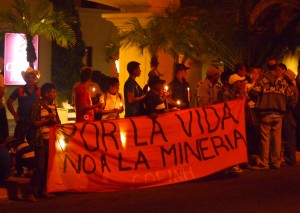
The night before the anti-mining march, COPINH members held a candle lit vigil outside the inauguration ceremony of the Mining Congress. The banner reads “For life, No to Mining, COPINH”
In reality, the project’s huge demand for fresh-water dried up 17 out of 21 of the water sources – streams and creeks – of the local area. The loss of farmland and water reportedly hit local agriculture for the 7,000 residents in the area so hard that their production dropped by 70%. Meanwhile, the toxic tailing ponds leaked into the ground water, and spilled several times in storms. In 2007 local drinking water tested positive for contamination, but the Ministry of Health suppressed this data until 2011. Some 40,000 people have been exposed to this contamination, which has caused widespread skin disease, eye problems, birth deformities and cancer. Independent research published in 2006 showed infant mortality in the mine-affected region 12 times higher than the national average, and 33 times higher in families of mine workers. In 2008 the growing opposition and evidence against the mine led to its closure, but Goldcorp or its local subsidiary Entre Mares has never taken responsibility for any of the problems caused, and retains the right to return to complete its concession [7, 8].
Valle de Siria is the example that the anti-mining groups most frequently cite in their attempt to push back against Juan Orlando’s open-door mining policy, but there were many more stories of mining damage at the protests. Benjamin de Sedeño is a member of CODDEFFAGOLF, the Committee for the Defence and Development of the Flora and Fauna of the Gulf of Fonseca. The gulf is the part of the Pacific ocean that Honduras meets. Several Honduran rivers empty into the gulf, including the mine-contaminated rivers Goascorán and Choluteca. De Sedeño told me that the golf is dying – its fish life has been decimated leaving the locals hungry and taking away their livelihoods. Big prawn farms – a staple business of the area – have shut down due to loss of their stock, taking an important source of employment. His communities want development, he told me, but not at the price of the ecosystems that they rely on.
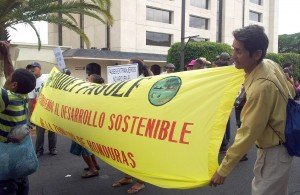
Benjamin de Sedeño holds the banner of CODDEFFAGOLF, the Committee for the Defence and Development of the Flora and Fauna of the Gulf of Fonseca, protesting against the loss of fish stocks, food and livelihoods on the Pacific coast
The indigenous Tolupanes who were members of the Indignado hunger strike told me how mining had affected them in Yoro department in the north of the country. Their communities have indigenous land titles that they gained in the 1800s, through the astonishingly prescient efforts of their forefathers. This should protect their land and its resources from privatisation in both Honduran and international law. Despite this it has not stopped mining projects draining most of their potable water supplies and contaminating what remains, just like in Valle de Siria. Their communities have suffered skin problems and facial sores. They told me that they have only managed to save 1 source of potable water safe, and only by fighting the incursion of mining companies to protect the 20 hectares around it from deforestation or contamination.
A Country for Sale – Exploitative Ideologies and The Global Perspective
The neoliberal ideology that supports Juan Orlando’s expanding mining project says that it will bring money and jobs to the country, but these promises are empty. Mining projects promise jobs, but according to Honduras’ National Coalition of Environmental Networks and Organisations (CONROA) only 1,743 jobs have ever been registered in Honduras from the mining sector. Meanwhile, mining’s land and water use usurps agriculture, which is the true mainstay of the country’s economy and employment [9].

Tomas Membreño, centre, talks at the anti-mining press conference of the Platform of Social and Popular Movements of Honduras – photo credit Radio Progreso, see reference 2
According to the 2013 New Mining Law, 6% of the export value of metal from Honduran mines should be paid in tax to the government [3]. This is a pathetically small payment for the devastation left behind, and almost 30% of their land area is already signed up to this fate. For Hondurans their oligarchy is selling their heritage off to transnational companies that care nothing for the development of the country. Regardless of the legislated price, the recent revelations have highlighted how Honduras’ corrupt politicians and businesses work together to steal state money and siphon it off into personal bank accounts. As CEHPRODEC’s José Espinoza explained to me, Honduras simply doesn’t have the strong state bodies to enforce the laws to protect the country’s environment and people from the damage from mining. Its officials are either under-resourced, or corrupt and in cahoots with the companies, or simply restrained by the government’s pro-mining stance.
Juan Orlando’s Mining Congress’ idea of “Responsible mining” is a fantasy in Honduras. Internationally it is a lie used to gloss over the destruction left by vampiric mining projects, not just in Honduras but throughout the developing world. The impact of these projects and the neoliberal ideology that supports them is exploitation, poverty and the stalling of development. In Honduras, the repressive state’s disconnection to its people drives this process to its extremes and paints it in sharp relief.

Hundreds of people representing dozens of civil society organisations were present. Here residents of Choluteca in the South of the country say “No to Mining Contamination”
Honduras is a long way from escaping from these problems but its people are up in arms against the exploitation. ENCA is currently running an online campaign to gather international voices to support them. The campaign is aimed at world leaders to pressurise Juan Orlando to capitulate to an international commission into Honduran corruption. But it also demands that our leaders rethink the impact of the economic, trade and military relations we have with his government. Shining a light on the flawed assumptions behind these relationships – how they support corruption and fail Honduras’ people – is the first step towards reversing the exploitation we are inflicting on these countries. Please go to our action page to sign the petition in the UK, or for easy ways to help from other countries.
References
-
Primero Congreso Internacional de Minería en Honduras – 7th to 11th July 2015 – official website
- Radio Progresso Honduras – 7th July 2015 – “Plataforma de Movimientos Sociales y Populares de Honduras Se Pronuncian Contra Congreso de Mineria Promovido por Gobierno”
- Central Law Blog – 30th September 2013 – “Nueva Ley y Reglamento de Minería en Honduras”
-
Coalición Nacional de Redes y Organizaciones ambientales de Honduras (CONROA) – June 2015 – “La Mineria Otro Acto De Corrupción En Honduras”
- Organización Fraternal Negra Hondureña, OFRANEH – 8th July 2015 – “Corrupción Generalizada y el Congreso Internacional Minería-Honduras”
- COPINH – 5th July 2015 – “Llamamiento del COPINH ante el I Congreso Internacional de Minería a realizarse la próxima semana en Tegucigalpa ¡A movilizarnos!”
- Sandra Cuffe – 25th April 2015 – “Mine-affected communities in Honduras defend public access to water sources”
- Giorgio Trucchi, Opera Mundi – 7th September 2014 – translated to spanish at “Actividad minera deja rastro de enfermedades, destrucción ambiental y desempleo”
- Coalición Nacional de Redes y Organizaciones ambientales de Honduras (CONROA) – quoted 8th July 2015 – El Heraldo, “Honduras, sede de Congreso Internacional de Minería”

